steering FIAT DUCATO BASE CAMPER 2018 Owner handbook (in English)
[x] Cancel search | Manufacturer: FIAT, Model Year: 2018, Model line: DUCATO BASE CAMPER, Model: FIAT DUCATO BASE CAMPER 2018Pages: 304, PDF Size: 14.93 MB
Page 122 of 304
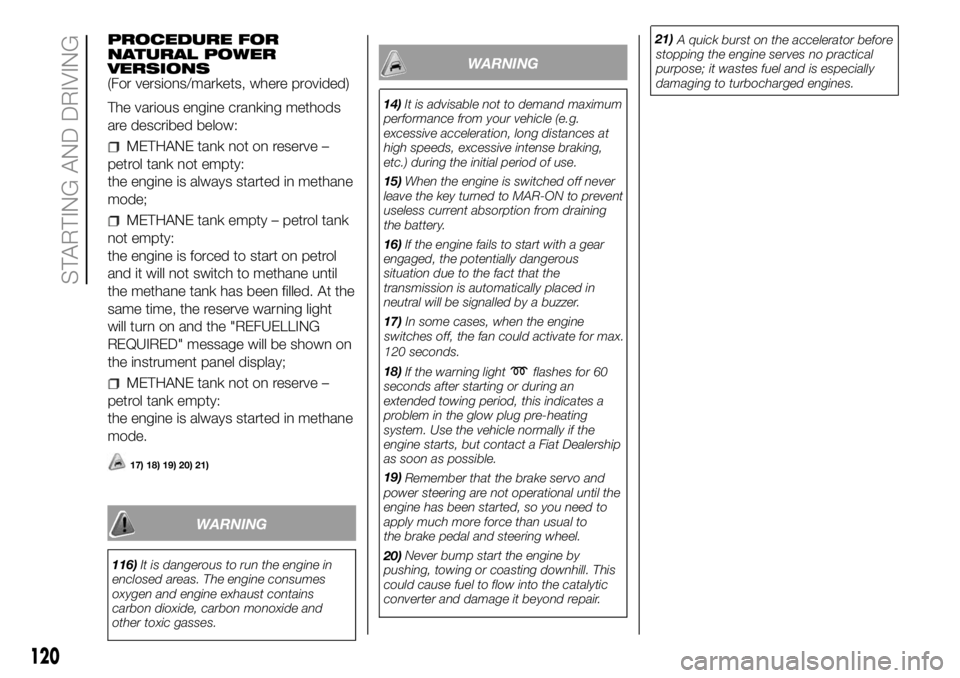
PROCEDURE FOR
NATURAL POWER
VERSIONS
(For versions/markets, where provided)
The various engine cranking methods
are described below:
METHANE tank not on reserve –
petrol tank not empty:
the engine is always started in methane
mode;
METHANE tank empty – petrol tank
not empty:
the engine is forced to start on petrol
and it will not switch to methane until
the methane tank has been filled. At the
same time, the reserve warning light
will turn on and the "REFUELLING
REQUIRED" message will be shown on
the instrument panel display;
METHANE tank not on reserve –
petrol tank empty:
the engine is always started in methane
mode.
17) 18) 19) 20) 21)
WARNING
116)It is dangerous to run the engine in
enclosed areas. The engine consumes
oxygen and engine exhaust contains
carbon dioxide, carbon monoxide and
other toxic gasses.
WARNING
14)It is advisable not to demand maximum
performance from your vehicle (e.g.
excessive acceleration, long distances at
high speeds, excessive intense braking,
etc.) during the initial period of use.
15)When the engine is switched off never
leave the key turned to MAR-ON to prevent
useless current absorption from draining
the battery.
16)If the engine fails to start with a gear
engaged, the potentially dangerous
situation due to the fact that the
transmission is automatically placed in
neutral will be signalled by a buzzer.
17)
If the warning light
flashes for 60
seconds after starting or during an
extended towing period, this indicates a
problem in the glow plug preheating
system. Use the vehicle normally if the
engine starts, but contact a Fiat Dealership
as soon as possible. 18)
Remember that the brake servo and
power steering are not operational until the
engine has been started, so you need to
apply much more force than usual to
the brake pedal and steering wheel. 19)
Never bump start the engine by
pushing, towing or coasting downhill. This
could cause fuel to flow into the catalytic
converter and damage it beyond repair. 20)A quick burst on the accelerator before
stopping the engine serves no practical
purpose; it wastes fuel and is especially
damaging to turbocharged engines. 21)
In some cases, when the engine
switches off, the fan could activate for max.
120 seconds.
120
STARTING AND DRIVING
Page 163 of 304
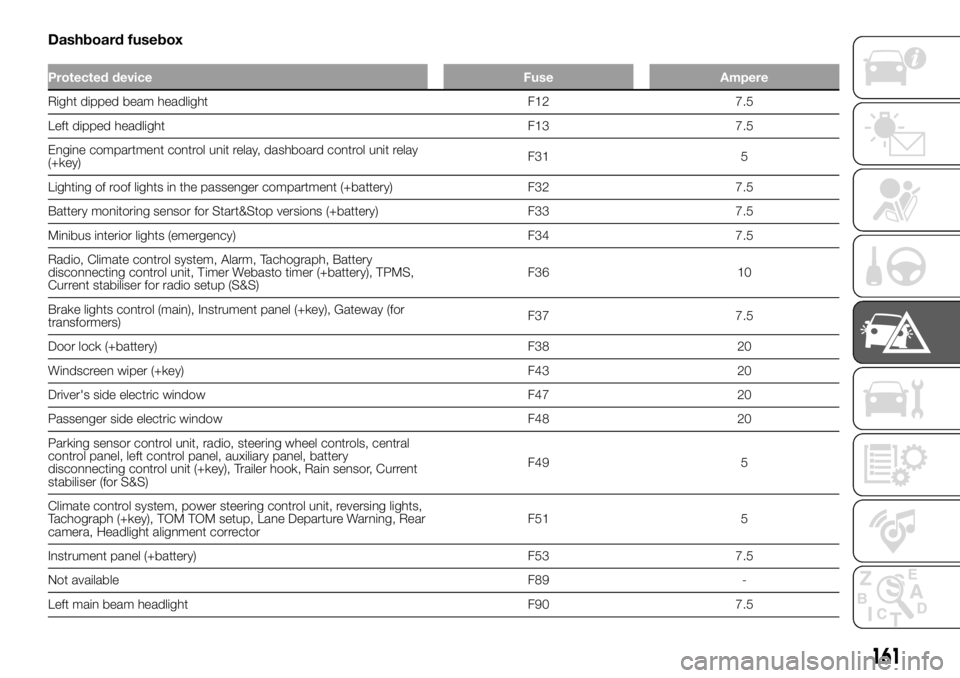
Dashboard fusebox
Protected device Fuse Ampere
Right dipped beam headlight F12 7.5
Left dipped headlight F13 7.5
Engine compartment control unit relay, dashboard control unit relay
(+key)F31 5
Lighting of roof lights in the passenger compartment (+battery) F32 7.5
Battery monitoring sensor for Start&Stop versions (+battery) F33 7.5
Minibus interior lights (emergency) F34 7.5
Radio, Climate control system, Alarm, Tachograph, Battery
disconnecting control unit, Timer Webasto timer (+battery), TPMS,
Current stabiliser for radio setup (S&S)F36 10
Brake lights control (main), Instrument panel (+key), Gateway (for
transformers)F37 7.5
Door lock (+battery) F38 20
Windscreen wiper (+key) F43 20
Driver's side electric window F47 20
Passenger side electric window F48 20
Parking sensor control unit, radio, steering wheel controls, central
control panel, left control panel, auxiliary panel, battery
disconnecting control unit (+key), Trailer hook, Rain sensor, Current
stabiliser (for S&S)F49 5
Climate control system, power steering control unit, reversing lights,
Tachograph (+key), TOM TOM setup, Lane Departure Warning, Rear
camera, Headlight alignment correctorF51 5
Instrument panel (+battery) F53 7.5
Not available F89 -
Left main beam headlight F90 7.5
161
Page 172 of 304
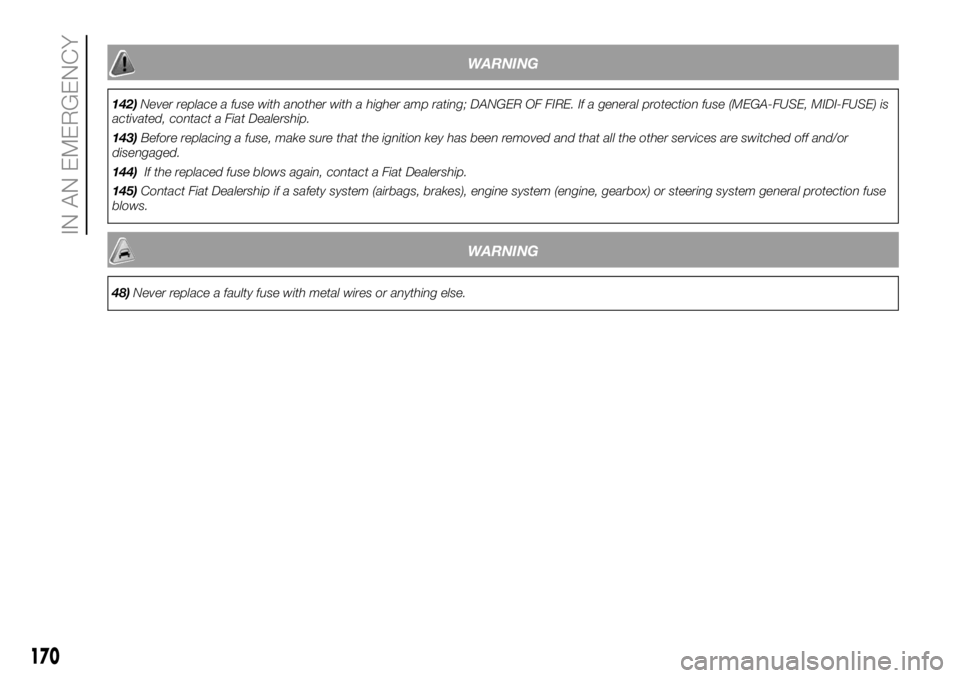
WARNING
142)Never replace a fuse with another with a higher amp rating; DANGER OF FIRE. If a general protection fuse (MEGA-FUSE, MIDI-FUSE) is
activated, contact a Fiat Dealership.
143)Before replacing a fuse, make sure that the ignition key has been removed and that all the other services are switched off and/or
disengaged.
144)If the replaced fuse blows again, contact a Fiat Dealership.
145)Contact Fiat Dealership if a safety system (airbags, brakes), engine system (engine, gearbox) or steering system general protection fuse
blows.
WARNING
48)Never replace a faulty fuse with metal wires or anything else.
170
IN AN EMERGENCY
Page 189 of 304
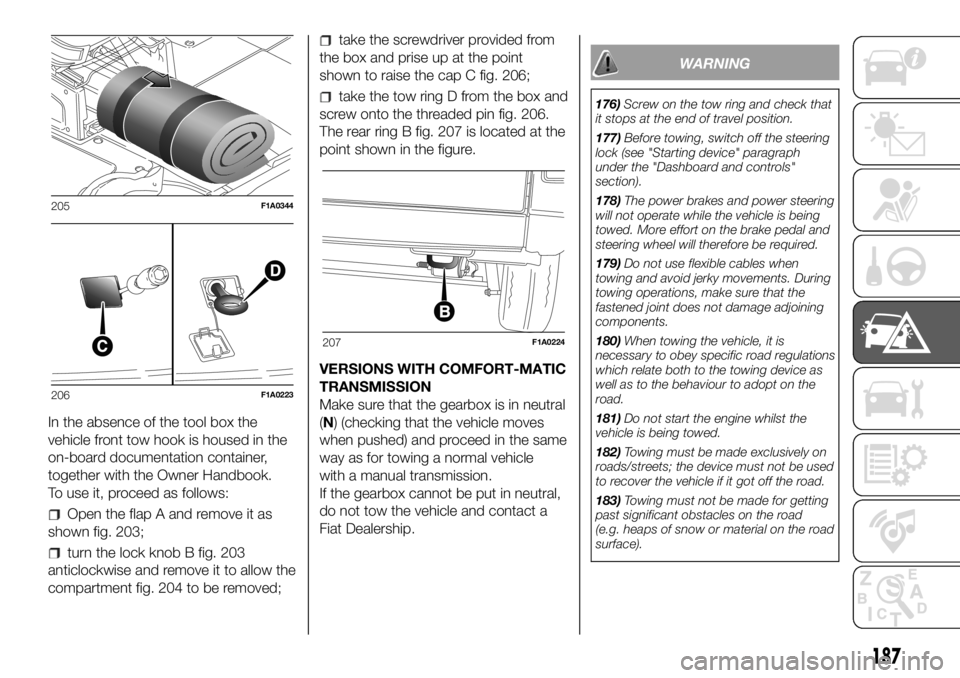
In the absence of the tool box the
vehicle front tow hook is housed in the
on-board documentation container,
together with the Owner Handbook.
To use it, proceed as follows:
Open the flap A and remove it as
shown fig. 203;
turn the lock knob B fig. 203
anticlockwise and remove it to allow the
compartment fig. 204 to be removed;
take the screwdriver provided from
the box and prise up at the point
shown to raise the cap C fig. 206;
take the tow ring D from the box and
screw onto the threaded pin fig. 206.
The rear ring B fig. 207 is located at the
point shown in the figure.
VERSIONS WITH COMFORT-MATIC
TRANSMISSION
Make sure that the gearbox is in neutral
(N) (checking that the vehicle moves
when pushed) and proceed in the same
way as for towing a normal vehicle
with a manual transmission.
If the gearbox cannot be put in neutral,
do not tow the vehicle and contact a
Fiat Dealership.
WARNING
176)Screw on the tow ring and check that
it stops at the end of travel position.
177)Before towing, switch off the steering
lock (see "Starting device" paragraph
under the "Dashboard and controls"
section).
178)The power brakes and power steering
will not operate while the vehicle is being
towed. More effort on the brake pedal and
steering wheel will therefore be required.
179)Do not use flexible cables when
towing and avoid jerky movements. During
towing operations, make sure that the
fastened joint does not damage adjoining
components.
180)When towing the vehicle, it is
necessary to obey specific road regulations
which relate both to the towing device as
well as to the behaviour to adopt on the
road.
181)Do not start the engine whilst the
vehicle is being towed.
182)Towing must be made exclusively on
roads/streets; the device must not be used
to recover the vehicle if it got off the road.
183)Towing must not be made for getting
past significant obstacles on the road
(e.g. heaps of snow or material on the road
surface).
205F1A0344
206F1A0223
207F1A0224
187
Page 201 of 304
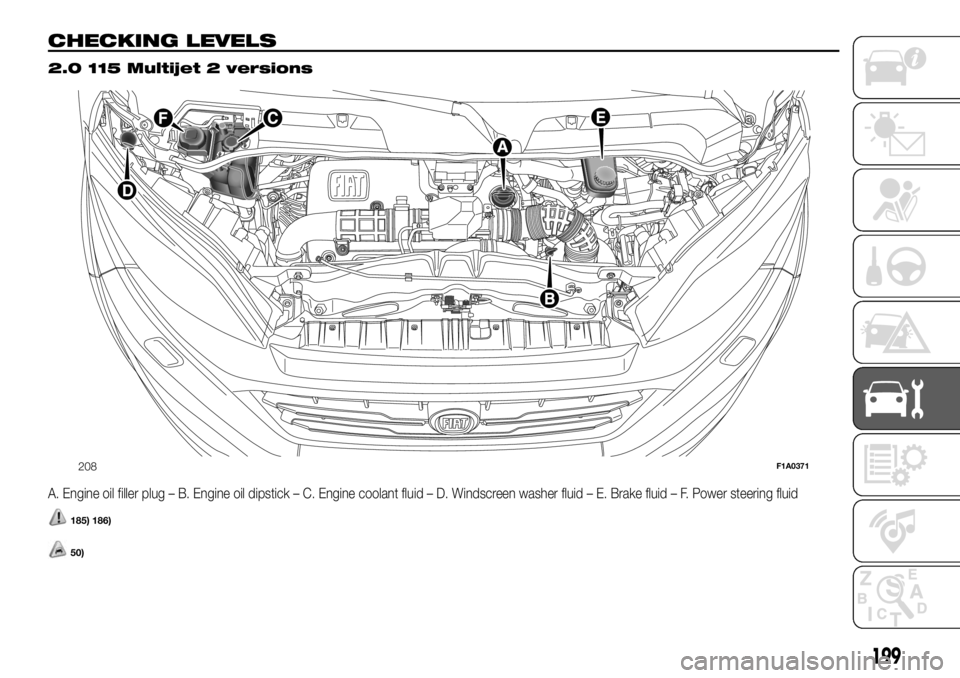
CHECKING LEVELS.
2.0 115 Multijet 2 versions
A. Engine oil filler plug – B. Engine oil dipstick – C. Engine coolant fluid – D. Windscreen washer fluid – E. Brake fluid – F. Power steering fluid
185) 186)
50)
208F1A0371
199
Page 202 of 304
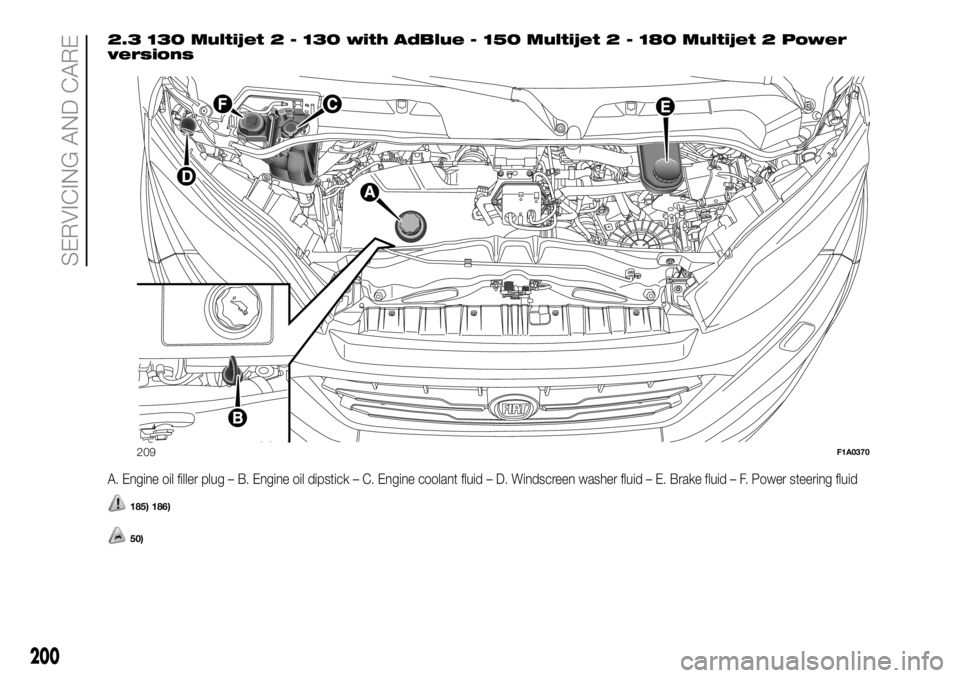
2.3 130 Multijet 2 - 130 with AdBlue - 150 Multijet 2 - 180 Multijet 2 Power
versions
A. Engine oil filler plug – B. Engine oil dipstick – C. Engine coolant fluid – D. Windscreen washer fluid – E. Brake fluid – F. Power steering fluid
185) 186)
50)
209F1A0370
200
SERVICING AND CARE
Page 203 of 304
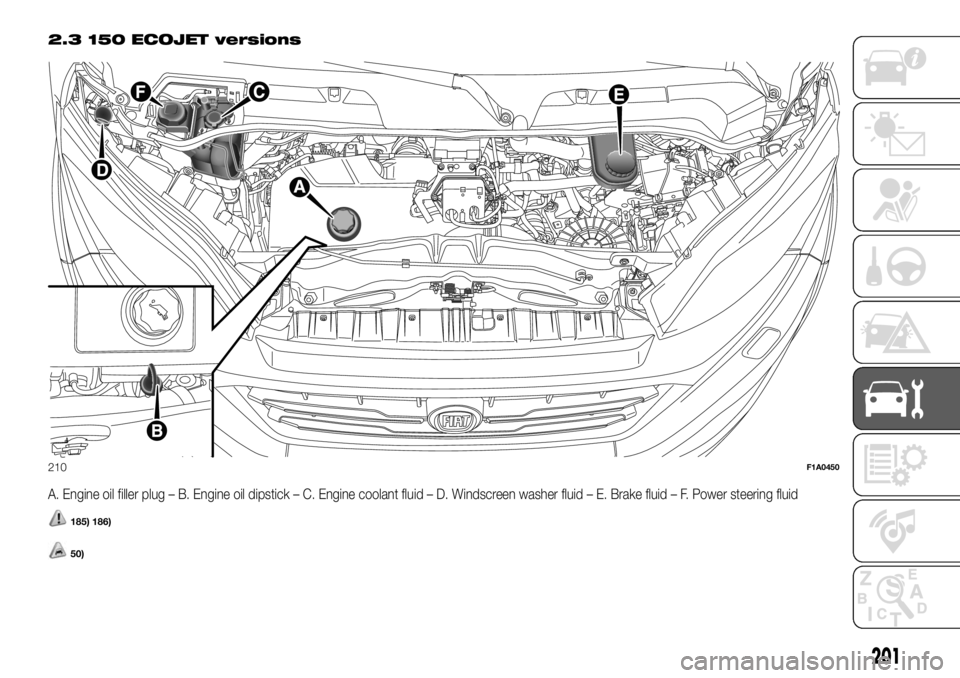
2.3 150 ECOJET versions
A. Engine oil filler plug – B. Engine oil dipstick – C. Engine coolant fluid – D. Windscreen washer fluid – E. Brake fluid – F. Power steering fluid
185) 186)
50)
210F1A0450
201
Page 204 of 304
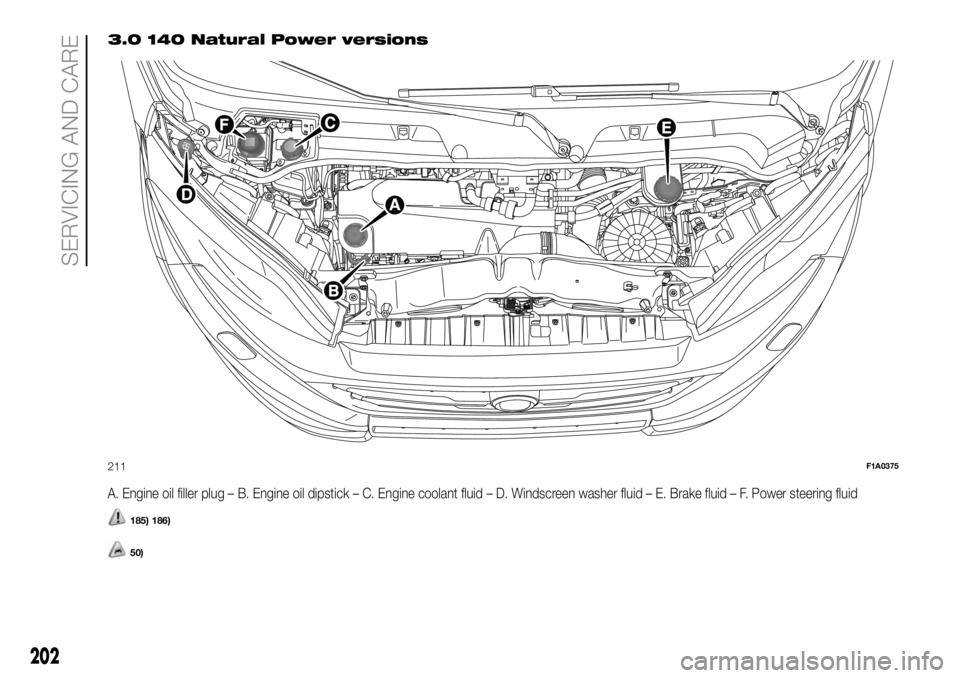
3.0 140 Natural Power versions
A. Engine oil filler plug – B. Engine oil dipstick – C. Engine coolant fluid – D. Windscreen washer fluid – E. Brake fluid – F. Power steering fluid
185) 186)
50)
211F1A0375
202
SERVICING AND CARE
Page 205 of 304
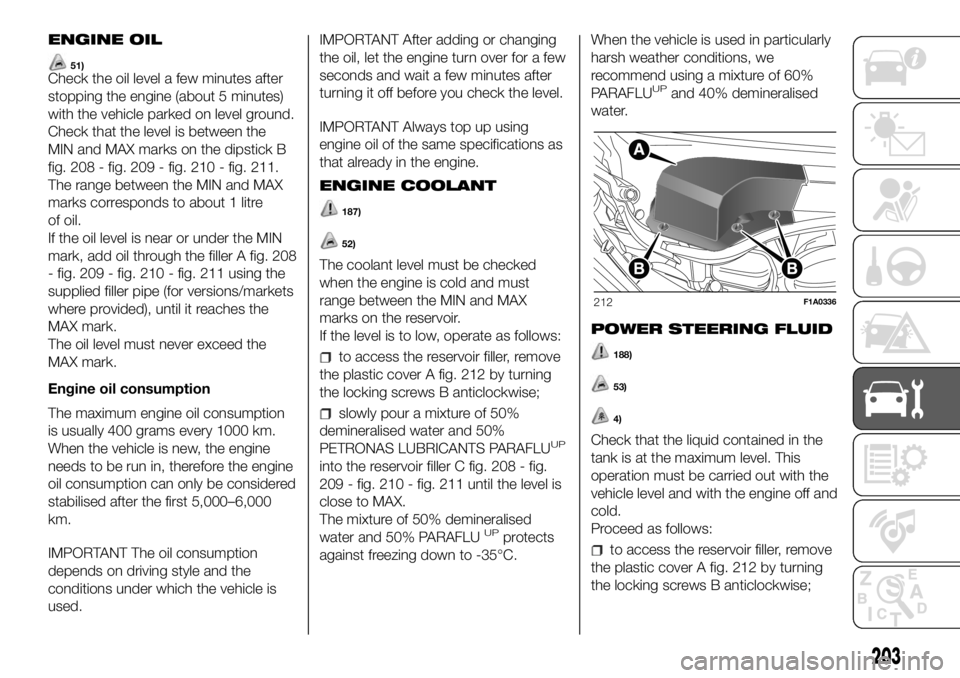
ENGINE OIL
51)Check the oil level a few minutes after
stopping the engine (about 5 minutes)
with the vehicle parked on level ground.
Check that the level is between the
MIN and MAX marks on the dipstick B
fig. 208 - fig. 209 - fig. 210 - fig. 211.
The range between the MIN and MAX
marks corresponds to about 1 litre
of oil.
If the oil level is near or under the MIN
mark, add oil through the filler A fig. 208
- fig. 209 - fig. 210 - fig. 211 using the
supplied filler pipe (for versions/markets
where provided), until it reaches the
MAX mark.
The oil level must never exceed the
MAX mark.
Engine oil consumption
The maximum engine oil consumption
is usually 400 grams every 1000 km.
When the vehicle is new, the engine
needs to be run in, therefore the engine
oil consumption can only be considered
stabilised after the first 5,000–6,000
km.
IMPORTANT The oil consumption
depends on driving style and the
conditions under which the vehicle is
used.IMPORTANT After adding or changing
the oil, let the engine turn over for a few
seconds and wait a few minutes after
turning it off before you check the level.
IMPORTANT Always top up using
engine oil of the same specifications as
that already in the engine.
ENGINE COOLANT
187)
52)
The coolant level must be checked
when the engine is cold and must
range between the MIN and MAX
marks on the reservoir.
If the level is to low, operate as follows:
to access the reservoir filler, remove
the plastic cover A fig. 212 by turning
the locking screws B anticlockwise;
slowly pour a mixture of 50%
demineralised water and 50%
PETRONAS LUBRICANTS PARAFLU
UP
into the reservoir filler C fig. 208 - fig.
209 - fig. 210 - fig. 211 until the level is
close to MAX.
The mixture of 50% demineralised
water and 50% PARAFLU
UPprotects
against freezing down to -35°C.When the vehicle is used in particularly
harsh weather conditions, we
recommend using a mixture of 60%
PARAFLU
UPand 40% demineralised
water.
POWER STEERING FLUID
188)
53)
4)
Check that the liquid contained in the
tank is at the maximum level. This
operation must be carried out with the
vehicle level and with the engine off and
cold.
Proceed as follows:
to access the reservoir filler, remove
the plastic cover A fig. 212 by turning
the locking screws B anticlockwise;
212F1A0336
203
Page 206 of 304
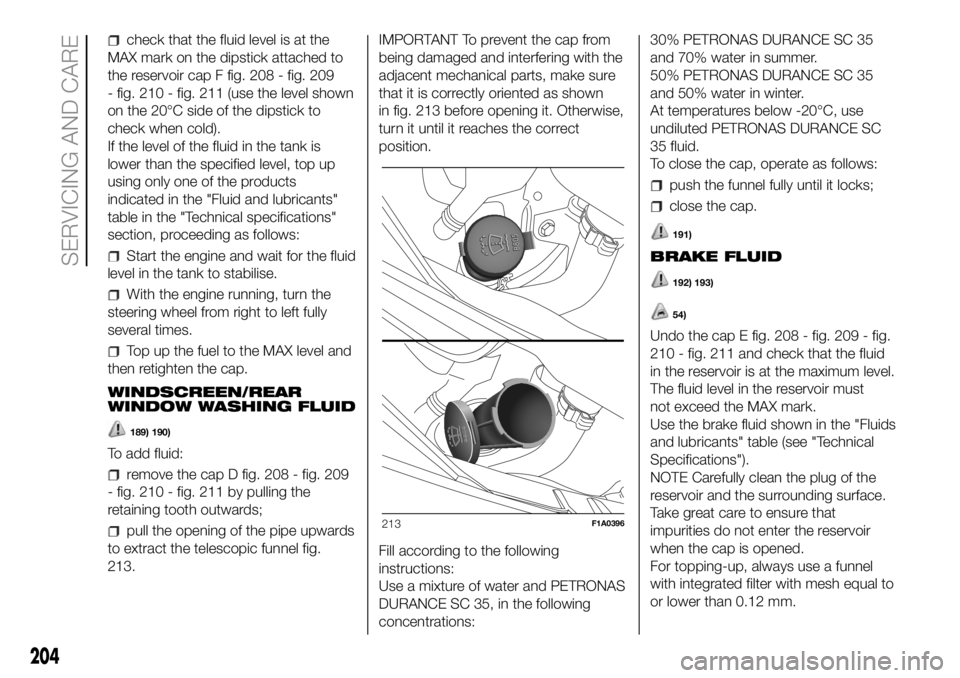
check that the fluid level is at the
MAX mark on the dipstick attached to
the reservoir cap F fig. 208 - fig. 209
- fig. 210 - fig. 211 (use the level shown
on the 20°C side of the dipstick to
check when cold).
If the level of the fluid in the tank is
lower than the specified level, top up
using only one of the products
indicated in the "Fluid and lubricants"
table in the "Technical specifications"
section, proceeding as follows:
Start the engine and wait for the fluid
level in the tank to stabilise.
With the engine running, turn the
steering wheel from right to left fully
several times.
Top up the fuel to the MAX level and
then retighten the cap.
WINDSCREEN/REAR
WINDOW WASHING FLUID
189) 190)
To add fluid:
remove the cap D fig. 208 - fig. 209
- fig. 210 - fig. 211 by pulling the
retaining tooth outwards;
pull the opening of the pipe upwards
to extract the telescopic funnel fig.
213.IMPORTANT To prevent the cap from
being damaged and interfering with the
adjacent mechanical parts, make sure
that it is correctly oriented as shown
in fig. 213 before opening it. Otherwise,
turn it until it reaches the correct
position.
Fill according to the following
instructions:
Use a mixture of water and PETRONAS
DURANCE SC 35, in the following
concentrations:30% PETRONAS DURANCE SC 35
and 70% water in summer.
50% PETRONAS DURANCE SC 35
and 50% water in winter.
At temperatures below -20°C, use
undiluted PETRONAS DURANCE SC
35 fluid.
To close the cap, operate as follows:
push the funnel fully until it locks;
close the cap.
191)
BRAKE FLUID
192) 193)
54)
Undo the cap E fig. 208 - fig. 209 - fig.
210 - fig. 211 and check that the fluid
in the reservoir is at the maximum level.
The fluid level in the reservoir must
not exceed the MAX mark.
Use the brake fluid shown in the "Fluids
and lubricants" table (see "Technical
Specifications").
NOTE Carefully clean the plug of the
reservoir and the surrounding surface.
Take great care to ensure that
impurities do not enter the reservoir
when the cap is opened.
For topping-up, always use a funnel
with integrated filter with mesh equal to
or lower than 0.12 mm.
213F1A0396
204
SERVICING AND CARE